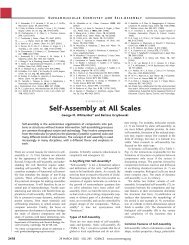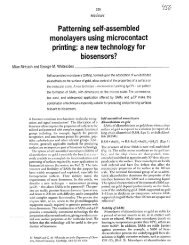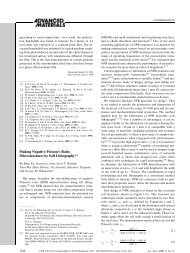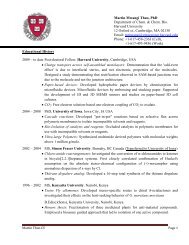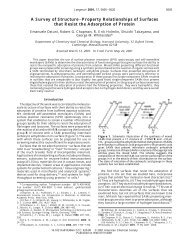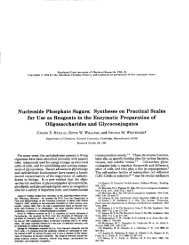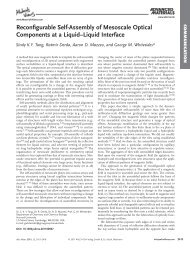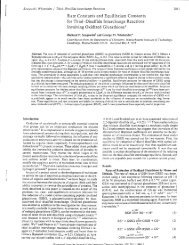Self-Assembled Monolayers of Thiolates on Metals as - Whitesides ...
Self-Assembled Monolayers of Thiolates on Metals as - Whitesides ...
Self-Assembled Monolayers of Thiolates on Metals as - Whitesides ...
You also want an ePaper? Increase the reach of your titles
YUMPU automatically turns print PDFs into web optimized ePapers that Google loves.
1142 Chemical Reviews, 2005, Vol. 105, No. 4 Love et al.<br />
number <str<strong>on</strong>g>of</str<strong>on</strong>g> different juncti<strong>on</strong>s c<strong>on</strong>firm that the current<br />
through devices c<strong>on</strong>taining SAMs <str<strong>on</strong>g>of</str<strong>on</strong>g> these<br />
molecules depends exp<strong>on</strong>entially <strong>on</strong> the thickness <str<strong>on</strong>g>of</str<strong>on</strong>g><br />
the SAM. These results suggest the primary mechanism<br />
<str<strong>on</strong>g>of</str<strong>on</strong>g> c<strong>on</strong>ductance through these molecules is<br />
electr<strong>on</strong> tunneling. 4,560,595,608-610<br />
Challenges for Molecular Electr<strong>on</strong>ics. Studying<br />
the rates <str<strong>on</strong>g>of</str<strong>on</strong>g> electr<strong>on</strong> transfer and mechanisms for<br />
charge transport in molecules c<strong>on</strong>fined in solid-state<br />
juncti<strong>on</strong>s presents several challenges that are different<br />
from those familiar from studies <str<strong>on</strong>g>of</str<strong>on</strong>g> electr<strong>on</strong>transfer<br />
processes in soluti<strong>on</strong> or at electrode-soluti<strong>on</strong><br />
interfaces. Some challenges relate to the ambiguity<br />
<str<strong>on</strong>g>of</str<strong>on</strong>g> the structure, orientati<strong>on</strong>, and identity <str<strong>on</strong>g>of</str<strong>on</strong>g> the<br />
species present in the juncti<strong>on</strong> after <strong>as</strong>sembly or<br />
fabricati<strong>on</strong>; others relate to uncertainties c<strong>on</strong>cerning<br />
the interfaces between the molecules and the electrical<br />
c<strong>on</strong>tacts. 611 Still others are c<strong>on</strong>nected to the<br />
relatively harsh processing c<strong>on</strong>diti<strong>on</strong>s used in fabricating<br />
or testing the devices (thermal evaporati<strong>on</strong>,<br />
intense electric fields) and potential for structural<br />
rearrangements <str<strong>on</strong>g>of</str<strong>on</strong>g> these interfaces (for example,<br />
formati<strong>on</strong> <str<strong>on</strong>g>of</str<strong>on</strong>g> metal filaments bridging two electrodes<br />
612 ); the latter is especially important for juncti<strong>on</strong>s<br />
involving gold. The development <str<strong>on</strong>g>of</str<strong>on</strong>g> unambiguous<br />
and predictive models that correlate the structure<br />
<str<strong>on</strong>g>of</str<strong>on</strong>g> individual molecules to their electr<strong>on</strong>ic properties<br />
will require research that addresses the factors<br />
described below.<br />
Structure <str<strong>on</strong>g>of</str<strong>on</strong>g> “Complex” SAMs. The majority <str<strong>on</strong>g>of</str<strong>on</strong>g><br />
the types <str<strong>on</strong>g>of</str<strong>on</strong>g> molecules that are predicted to have<br />
interesting electr<strong>on</strong>ic characteristics (insulating, c<strong>on</strong>ducting,<br />
rectifying) are not simple alkanethiols; they<br />
c<strong>on</strong>tain various organic functi<strong>on</strong>al groups, interlocking<br />
rings, branching structures, and organometallic<br />
redox sites. 613 The orientati<strong>on</strong> and arrangement <str<strong>on</strong>g>of</str<strong>on</strong>g><br />
molecules formed from thiols <strong>on</strong> gold, silver, palladium,<br />
and platinum are <strong>on</strong>ly known (to varying<br />
degrees) for n-alkanethiols, some aromatic compounds<br />
(biphenyls, phenylene ethynylenes), 614 and<br />
related compounds with minor structural variati<strong>on</strong>s<br />
(different end groups) (Table 2). SAMs <str<strong>on</strong>g>of</str<strong>on</strong>g> other types<br />
<str<strong>on</strong>g>of</str<strong>on</strong>g> molecules simply are not characterized.<br />
Nature <str<strong>on</strong>g>of</str<strong>on</strong>g> the Interfaces between SAMs and<br />
Their Electrical C<strong>on</strong>tacts. How the number and<br />
type <str<strong>on</strong>g>of</str<strong>on</strong>g> interfaces (van der Waals, chemical b<strong>on</strong>ding,<br />
vacuum, solvent) affect the c<strong>on</strong>ductance observed for<br />
molecules in the juncti<strong>on</strong>s is unclear. At le<strong>as</strong>t <strong>on</strong>e<br />
interface usually involves a metal-thiolate b<strong>on</strong>d<br />
(when a SAM is used <strong>as</strong> the organic comp<strong>on</strong>ent). The<br />
influence <str<strong>on</strong>g>of</str<strong>on</strong>g> this interface <strong>on</strong> the electrical behavior<br />
<str<strong>on</strong>g>of</str<strong>on</strong>g> the system is, however, poorly understood, 576<br />
especially for different types <str<strong>on</strong>g>of</str<strong>on</strong>g> metals with substantially<br />
different surface chemistries, e.g., palladium<br />
and silver (secti<strong>on</strong> 3.1).<br />
In most juncti<strong>on</strong>s there is even less knowledge<br />
regarding the nature <str<strong>on</strong>g>of</str<strong>on</strong>g> the electrical c<strong>on</strong>tact between<br />
the SAM and the sec<strong>on</strong>d electrode attached to the<br />
SAM and its influence <strong>on</strong> electr<strong>on</strong> transport. It is<br />
evident that evaporati<strong>on</strong> <str<strong>on</strong>g>of</str<strong>on</strong>g> a metal electrode <strong>on</strong>to the<br />
SAM can have a number <str<strong>on</strong>g>of</str<strong>on</strong>g> detrimental outcomes<br />
including formati<strong>on</strong> <str<strong>on</strong>g>of</str<strong>on</strong>g> metallic filaments and extensive<br />
chemical reacti<strong>on</strong>s with the SAM. 612,615 Other<br />
c<strong>on</strong>tacts, such <strong>as</strong> scanning probes and mercury drops,<br />
may be less damaging than evaporated c<strong>on</strong>tacts, but<br />
these juncti<strong>on</strong>s introduce additi<strong>on</strong>al interfaces (SAM/<br />
vacuum/electrode or SAM/solvent/electrode) that also<br />
incre<strong>as</strong>e the complexity <str<strong>on</strong>g>of</str<strong>on</strong>g> the system. Rogers and<br />
co-workers reported a procedure for forming s<str<strong>on</strong>g>of</str<strong>on</strong>g>tlaminate<br />
c<strong>on</strong>tacts that might serve to eliminate some<br />
<str<strong>on</strong>g>of</str<strong>on</strong>g> the most serious problems encountered with metal<br />
c<strong>on</strong>tacts evaporated <strong>on</strong> top <str<strong>on</strong>g>of</str<strong>on</strong>g> organic thin films. 616<br />
Mechanisms <str<strong>on</strong>g>of</str<strong>on</strong>g> Electr<strong>on</strong> Transport in Metal-<br />
Molecule(s)-Metal Juncti<strong>on</strong>s. The b<strong>as</strong>ic mechanism<br />
for electr<strong>on</strong> transport in these types <str<strong>on</strong>g>of</str<strong>on</strong>g> systems<br />
is generally thought to involve electr<strong>on</strong> tunneling-a<br />
process where the molecule mediates the electr<strong>on</strong><br />
transfer but the electr<strong>on</strong> does not reside <strong>on</strong> the<br />
molecule for any significant period <str<strong>on</strong>g>of</str<strong>on</strong>g> time-or, perhaps<br />
in some c<strong>as</strong>es, res<strong>on</strong>ant tunneling. 559,617 The<br />
subtle details <str<strong>on</strong>g>of</str<strong>on</strong>g> the electr<strong>on</strong> tunneling process remain<br />
c<strong>on</strong>troversial, however, especially in molecules<br />
that are more complicated than linear alkane chains.<br />
Also, the degree to which other c<strong>on</strong>ducti<strong>on</strong> mechanisms,<br />
such <strong>as</strong> thermi<strong>on</strong>ic emissi<strong>on</strong> (transport above<br />
the potential barrier <str<strong>on</strong>g>of</str<strong>on</strong>g> the juncti<strong>on</strong>) or electr<strong>on</strong><br />
hopping (transport where the electr<strong>on</strong> does localize<br />
to specific sites in the molecule during transport),<br />
c<strong>on</strong>tribute to the total current remains an open<br />
questi<strong>on</strong>. Temperature-dependent current me<strong>as</strong>urements<br />
are a comm<strong>on</strong> method for analyzing solid-state<br />
semic<strong>on</strong>ductor devices but rarely are used to analyze<br />
molecule-b<strong>as</strong>ed devices; these me<strong>as</strong>urements may<br />
provide some mechanistic details <str<strong>on</strong>g>of</str<strong>on</strong>g> how the electr<strong>on</strong>s<br />
are moving through the molecule in the juncti<strong>on</strong>.<br />
4,608,618<br />
Perturbati<strong>on</strong>s to the Electr<strong>on</strong>ic and Vibrati<strong>on</strong>al<br />
States <str<strong>on</strong>g>of</str<strong>on</strong>g> Molecules. The effect <str<strong>on</strong>g>of</str<strong>on</strong>g> the intense<br />
electric fields applied in these me<strong>as</strong>urements <strong>on</strong> the<br />
energy levels within the molecules is not known.<br />
Inel<strong>as</strong>tic tunneling spectroscopy (IETS) is <strong>on</strong>e method<br />
to determine the vibrati<strong>on</strong>al states excited in the<br />
molecule during tunneling events and can c<strong>on</strong>firm<br />
the presence <str<strong>on</strong>g>of</str<strong>on</strong>g> the molecule in the juncti<strong>on</strong> after it<br />
is formed. 609,619 Unlike IR and Raman spectroscopy,<br />
the selecti<strong>on</strong> rules for excitati<strong>on</strong> <str<strong>on</strong>g>of</str<strong>on</strong>g> different modes<br />
are not well understood.<br />
Interpretati<strong>on</strong> <str<strong>on</strong>g>of</str<strong>on</strong>g> I-V Curves for Two-Terminal<br />
Devices. Experimentally observed I-V data are<br />
difficult, if not impossible, to interpret correctly from<br />
two-terminal juncti<strong>on</strong>s because small variati<strong>on</strong>s in<br />
the electrostatic envir<strong>on</strong>ment near the juncti<strong>on</strong> and<br />
in the electr<strong>on</strong>ic and physical couplings between the<br />
molecules and the electrical c<strong>on</strong>tacts affect the me<strong>as</strong>ured<br />
resp<strong>on</strong>se. The additi<strong>on</strong> <str<strong>on</strong>g>of</str<strong>on</strong>g> a third electrode (a<br />
gate) to metal-molecule(s)-metal juncti<strong>on</strong>s provides<br />
a means to vary the electrostatic envir<strong>on</strong>ment <str<strong>on</strong>g>of</str<strong>on</strong>g> the<br />
molecule in a c<strong>on</strong>trolled manner and eliminates some<br />
<str<strong>on</strong>g>of</str<strong>on</strong>g> the variability comm<strong>on</strong> in two-terminal juncti<strong>on</strong>s.<br />
605,620<br />
Defects in Juncti<strong>on</strong>s. The role <str<strong>on</strong>g>of</str<strong>on</strong>g> defects (both<br />
intrinsic and extrinsic) <strong>on</strong> the me<strong>as</strong>ured electrical<br />
resp<strong>on</strong>ses h<strong>as</strong> been recognized <strong>as</strong> a problem (Figure<br />
17). There are, however, no real tools for characterizing<br />
their role in the electr<strong>on</strong>-transfer processes and<br />
no good techniques for reproducing the defects in<br />
experimental systems. Some defects, such <strong>as</strong> filaments<br />
formed by evaporati<strong>on</strong>, can be eliminated by




